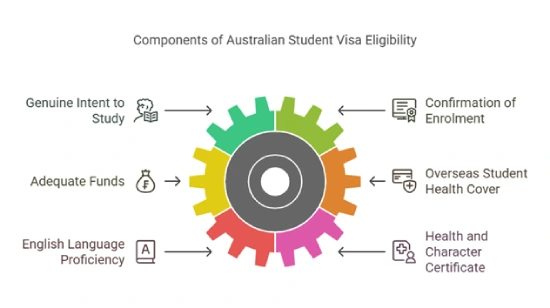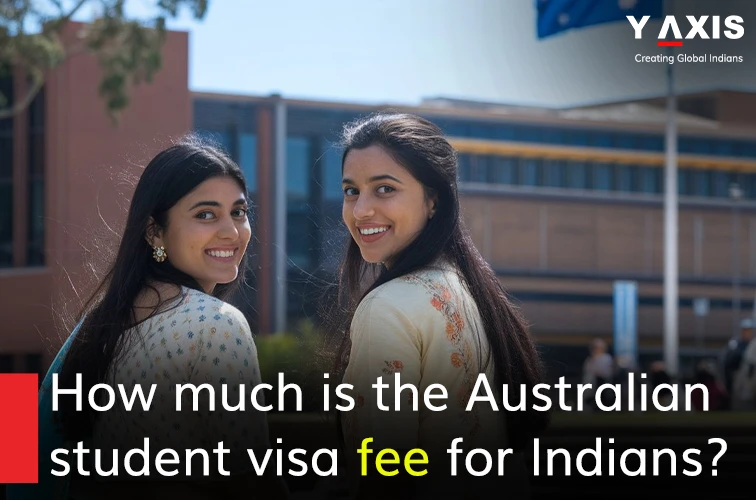Posted on March 08 2025
How much is the Australian student visa fee for Indians?
By , Editor
Updated March 11 2025
The fee for an Australian student visa (subclass 500) for Indian applicants is AUD 1,600. The new fee structure for Australia student visas took effect on July 1, 2024. Applicants must also incur the cost of Overseas Student Health Coverage (OSHC), dependents' expenses, and other additional charges.
*Want assistance in applying for Australia student visa? Y-Axis is here to support you with the process.
Breakdown of Australia student visa fee
A detailed breakdown of the Australian student visa cost is given below.
|
Type |
Fee |
|
Student Visa Application Fee |
AUD 1600 |
|
Additional Applicant |
Under 18: AUD 175 |
|
Over 18: AUD 530 |
|
|
Overseas Student Health Coverage (OSHC) |
AUD 500 |
|
Tuition Fees |
The tuition fees depend on the study program and university. |
|
Health Checks |
The cost of health checks depends on the country of origin for applicants. |
|
Police Checks |
Obtaining police clearance certificates may incur additional costs. |
|
Biometrics Test |
The charges of compiling biometric information vary depending on the applicant. |
|
Subsequent Temporary Application Charge |
This charge may apply to specific visa extensions. |
*Need guidance to study in Australia? Sign up with Y-Axis for end-to-end support with the process.
Eligibility for Australia student visa
The eligibility criteria for the student visa in Australia are given below. You must:
- Demonstrate your genuine intent to study in Australia.
- Have a Confirmation of Enrolment (CoE) from a designated learning institute in Australia.
- Have adequate funds to support yourself in Australia.
- Have a valid Overseas Student Health Cover (OSHC)
- Have the required English language proficiency
- Have a good health and character certificate.

Read more…
MATES program welcomes 3000 Indian students in Australia. Apply now!
Requirements for Australia student visa
You must provide the following documents to apply for the Australia student visa. You must provide:
- A valid passport.
- Passport-sized photographs taken recently.
- Confirmation of Enrolment (CoE) from a designated learning institute in Australia
- A hand-written Genuine Temporary Entrant (GTE) statement to explain your intention to study in Australia and your intent to return to your home country after graduating.
- Previous academic certificates.
- English language proficiency test results.
- Proof of sufficient funds to sponsor yourself.
- An Overseas Student Health Cover (OSHC) valid for the duration of your study program in Australia.
- Good health and character certificate.
- A Confirmation of Appropriate Accommodation and Welfare (CAAW) letter from your parents or sponsor if you are under the age of 18.
Processing time for Australian student visa
Detailed information about the processing time for an Australia student visa is below.
|
Type of Australia Student Visas |
Processing Time |
|
Student Visa (subclass 500) - Higher Education |
50 percent of visa applications are processed under 34 days |
|
90 percent of applications are processed under 5 months |
|
|
Student Visa (subclass 500) - Postgraduate Research Sector |
50 percent of applications are processed under 27 days |
|
90 percent of applications are processed under 4 months |
|
|
Temporary Graduate Student Visa (subclass 485): Post Higher Education Work |
90 percent of applications are processed within 7 months |
|
90 percent of applications are processed under 8 months |
Also read…
Australia is welcoming 270,000 international students in 2025
Steps to apply for an Australia student visa from India
The detailed procedure to apply for an Australia student visa in Australia is given below.
Step 1: Research the course and university you wish to study in Australia.
Step 2: Check if you are eligible for an Australian student visa.
Step 3: Arrange the necessary documents for the visa application.
Step 4: Submit the duly filled out student visa application.
Step 5: Receive the student visa and fly to Australia for studies.
*Looking for guidance with Australia immigration? Contact Y-Axis, the world's No. 1 overseas immigration company, for comprehensive support with the process.
Tags:
Australian student visa fee for Indians
Australia student visa fee
Australian student visa fee for Indians
Australian student visa fee
Australia student visa fee
Australian student visa. Australia student visa fee
study in Australia
Share
Options for you by Y-Axis
Get it on your mobile
Get News alerts
Contact Y-Axis

